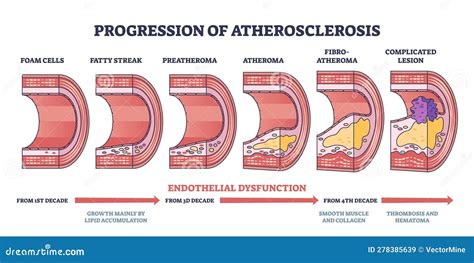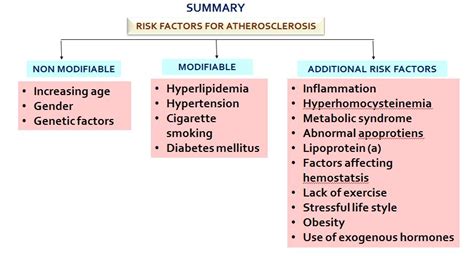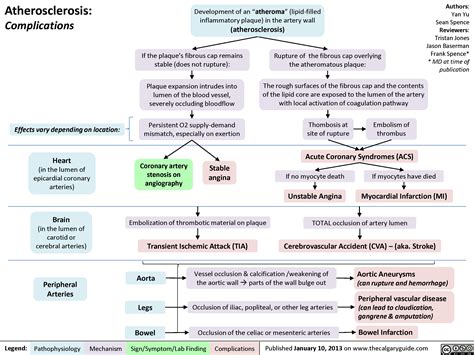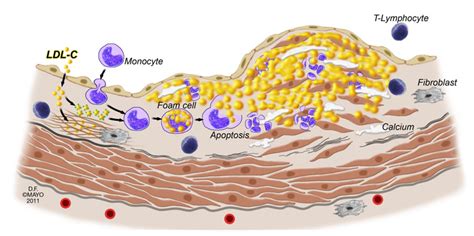Intro
Discover how atherosclerosis develops through 5 key factors, including plaque buildup, inflammation, and high blood pressure, affecting cardiovascular health and increasing heart disease risk.
Atherosclerosis is a complex and multifaceted condition that affects millions of people worldwide. It is a leading cause of cardiovascular disease, which is the number one cause of death globally. Atherosclerosis is a condition characterized by the buildup of plaque in the arteries, which can lead to blockages, reducing blood flow and oxygen delivery to vital organs. In this article, we will delve into the ways atherosclerosis happens, exploring the various mechanisms and risk factors that contribute to its development.
The importance of understanding atherosclerosis cannot be overstated. By grasping the underlying causes and mechanisms of the condition, individuals can take proactive steps to prevent or manage the disease. Atherosclerosis is a preventable condition, and lifestyle modifications, such as a healthy diet, regular exercise, and stress management, can significantly reduce the risk of developing the disease. Furthermore, early detection and treatment can help mitigate the consequences of atherosclerosis, reducing the risk of cardiovascular events, such as heart attacks and strokes.
Atherosclerosis is a gradual process that occurs over many years, often without noticeable symptoms. The condition is influenced by a combination of genetic, environmental, and lifestyle factors, which can increase the risk of developing the disease. As we explore the ways atherosclerosis happens, it becomes clear that the condition is not solely the result of one or two factors, but rather a complex interplay of various mechanisms and risk factors. By understanding these factors, individuals can take a proactive approach to preventing or managing atherosclerosis, reducing the risk of cardiovascular disease and improving overall health.
Introduction to Atherosclerosis

Causes of Atherosclerosis
The causes of atherosclerosis are multifaceted and complex. Some of the key factors that contribute to the development of the condition include: * High blood pressure * High cholesterol * Smoking * Diabetes * Obesity * Physical inactivity * Stress These factors can damage the inner lining of the arteries, making them more susceptible to plaque buildup. Additionally, certain genetic conditions, such as familial hypercholesterolemia, can increase the risk of developing atherosclerosis.How Atherosclerosis Develops

Stages of Atherosclerosis
The stages of atherosclerosis include: 1. **Initiation**: The inner lining of the artery becomes damaged, making it more susceptible to plaque buildup. 2. **Progression**: The plaque grows and hardens, narrowing the artery and reducing blood flow. 3. **Rupture**: The plaque ruptures, releasing debris into the bloodstream and triggering a blood clot. 4. **Blockage**: The blood clot blocks the artery, reducing blood flow and oxygen delivery to vital organs.Risk Factors for Atherosclerosis

Prevention and Treatment
Preventing and treating atherosclerosis involves a combination of lifestyle modifications and medical therapies. Some of the key strategies include: * **Healthy diet**: Eating a healthy, balanced diet that is low in saturated and trans fats, salt, and sugar. * **Regular exercise**: Engaging in regular physical activity, such as walking, running, or swimming. * **Stress management**: Managing stress through techniques such as meditation, yoga, or deep breathing. * **Medications**: Taking medications, such as statins or beta blockers, to lower cholesterol and blood pressure.Complications of Atherosclerosis

Diagnosis and Testing
Diagnosing and testing for atherosclerosis involves a combination of physical exams, medical history, and diagnostic tests. Some of the key tests include: * **Blood tests**: Blood tests can measure cholesterol and triglyceride levels. * **Imaging tests**: Imaging tests, such as angiography or ultrasound, can visualize the arteries and detect blockages. * **Stress tests**: Stress tests can measure the heart's response to physical activity.Current Research and Developments

Future Directions
The future directions for atherosclerosis research and treatment are promising. Some of the key areas of focus include: * **Personalized medicine**: Personalized medicine involves tailoring treatment to an individual's unique genetic and environmental profile. * **Regenerative medicine**: Regenerative medicine involves using stem cells and other technologies to repair or replace damaged tissues. * **Public health initiatives**: Public health initiatives are focused on promoting healthy lifestyles and reducing the risk of developing atherosclerosis.What is atherosclerosis?
+Atherosclerosis is a condition characterized by the buildup of plaque in the arteries, which can lead to blockages, reducing blood flow and oxygen delivery to vital organs.
What are the risk factors for atherosclerosis?
+The risk factors for atherosclerosis include age, family history, high blood pressure, high cholesterol, smoking, and physical inactivity.
How is atherosclerosis diagnosed?
+Atherosclerosis is diagnosed through a combination of physical exams, medical history, and diagnostic tests, such as blood tests, imaging tests, and stress tests.
What are the complications of atherosclerosis?
+The complications of atherosclerosis can be severe and life-threatening, including heart attack, stroke, peripheral artery disease, and kidney disease.
How can atherosclerosis be prevented or treated?
+Atherosclerosis can be prevented or treated through a combination of lifestyle modifications, such as a healthy diet, regular exercise, and stress management, and medical therapies, such as medications and surgery.
In conclusion, atherosclerosis is a complex and multifaceted condition that affects millions of people worldwide. By understanding the ways atherosclerosis happens, individuals can take proactive steps to prevent or manage the disease. We invite you to share your thoughts and experiences with atherosclerosis in the comments below. If you found this article informative, please share it with your friends and family to help raise awareness about this important health topic. Together, we can work towards reducing the risk of cardiovascular disease and improving overall health.
